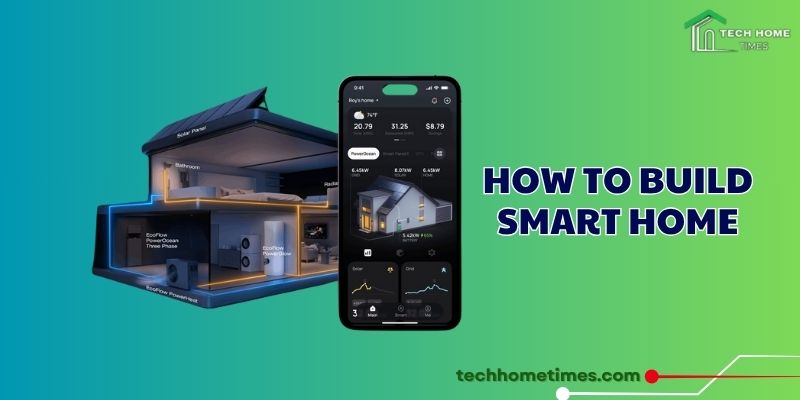How to Build Smart Home for Any Budget

Want to know how to build smart home systems that enhance your living space without breaking the bank? In 2025, creating a smart home is achievable for any budget, offering automation, security, and efficiency tailored to your financial capacity.
Contents
How to Build Smart Home for Any Budget?

Understanding how to build smart home for any budget starts with strategic planning and scalable technology, ensuring functionality at every price point. Whether you have $50 or $5,000, how to build smart home involves selecting affordable devices, leveraging open standards, and prioritizing needs.
Define Your Priorities
Identify core needs—energy savings, security, or convenience. For low budgets ($50–$200), focus on single-room solutions like smart plugs or bulbs.
Medium budgets ($200–$1,000) can include hubs and cameras, while high budgets ($1,000+) support whole-home systems with thermostats or air purifiers. This step guides how to build smart home aligned with your goals.
Select a Cost-Effective Platform
Choose a hub that supports Matter for broad compatibility. Low-budget options include Amazon Echo Dot ($30) or Google Nest Mini ($40), both with voice control in Vietnamese.
Medium budgets can opt for HomePod Mini ($99) for HomeKit integration, while high budgets might explore Samsung SmartThings Station ($150). A platform is key to how to build smart home efficiently.
Start with Affordable Devices
For low budgets, buy Wi-Fi-based smart plugs (Meross, $12) or bulbs (Sengled, $10) to control lamps or appliances. Medium budgets can add Wyze Cam v4 ($35) for security or Levoit Core 300S air purifier ($150) for health.
High budgets can include Ecobee SmartThermostat ($250) or Nanoleaf panels ($200). These choices shape how to build smart home within your means.
Ensure Network Reliability
Use an existing Wi-Fi router (2.4 GHz for compatibility) for low budgets, or upgrade to a Wi-Fi 6 router ($80) for medium budgets. High budgets can invest in mesh systems ($200) for larger homes. In Vietnam’s congested urban networks, a stable connection is critical for how to build smart home seamlessly.
Set Up and Connect Devices
Install devices per instructions—plug in, screw in bulbs, or mount cameras. Use apps to pair via Wi-Fi or hubs, taking 5–10 minutes per device. For low budgets, stick to app control; medium and high budgets can add voice assistants. This step actualizes how to build smart home with minimal effort.
Create Basic Automations
Use apps to set schedules, like turning off plugs at night (low budget) or linking cameras to lights for motion detection (medium/high budgets). Test routines to ensure reliability, refining how to build smart home for personalized functionality.
Expand Over Time
Add devices gradually as budget allows, ensuring Matter compatibility for future upgrades. This scalability is central to how to build smart home sustainably, allowing growth from a single bulb to a full ecosystem.
This approach demystifies how to build smart home for any budget, making smart technology accessible and practical.
Tips for Building a Budget-Friendly Smart Home

- Hunt for discounts on platforms like Shopee or Lazada in Vietnam, especially during sales like 11.11. Buy refurbished devices from trusted brands (e.g., Wyze cameras, $25) or bundles (Philips Hue starter kit, $80), saving 20–30%. This tactic supports how to build smart home on a tight budget.
- Opt for devices with dual roles, like smart plugs that monitor energy use or hubs doubling as speakers (Echo Dot). These reduce the need for multiple purchases, streamlining how to build smart home cost-effectively.
- Use manufacturer apps (e.g., Tapo, Wyze) for free automations instead of paid subscriptions. Avoid cloud storage fees by using local SD cards for cameras ($10). This keeps how to build smart home low-cost without sacrificing functionality.
- Smart bulbs (Sengled, $10) or plugs reduce electricity use by 15%, offsetting costs in Vietnam’s high-energy market. Energy monitoring via apps helps optimize usage, enhancing how to build smart home with long-term savings.
- Engage with X communities or Vietnam-based tech forums for setup tips, second-hand deals, or open-source automation scripts. Local insights tailor how to build smart home to regional challenges like humidity or power fluctuations.
- Start with one room (e.g., living area) and add devices monthly. For example, begin with a $15 plug, then add a $35 camera next month. This phased approach makes how to build smart home manageable across budgets.
- Use strong passwords, guest Wi-Fi networks, and free firmware updates to protect devices without extra costs. This ensures how to build smart home safely, avoiding potential cyber expenses.
Benefits of Smart Homes Across Budgets

Regardless of financial constraints, how to build smart home delivers universal benefits in 2025, making it a worthwhile investment for all:
- Automate tasks like turning off lights or scheduling appliances, saving 5–10 minutes daily. Even low-budget setups with plugs offer app-based control, simplifying life in busy Hanoi households.
- Smart devices reduce electricity use by 10–20%, per 2025 studies, with low-budget bulbs or medium-budget thermostats cutting bills. This is critical in Vietnam, where energy costs are rising.
- Budget-friendly cameras ($30) or motion sensors ($15) provide alerts and deterrence, enhancing safety in urban or rural homes. Medium/high budgets add locks or floodlights, amplifying protection.
- Low-budget air purifiers ($100) combat Vietnam’s urban pollution, reducing respiratory issues by 25%. Medium/high budgets include circadian lighting or climate control, boosting well-being.
- Start small and expand as funds allow, ensuring how to build smart home fits any budget. Matter compatibility means devices work together, from $10 bulbs to $250 thermostats.
By following a strategic guide, applying budget-friendly tips, and reaping universal benefits, Tech Home Times believes, how to build smart home becomes an accessible, rewarding endeavor.






